In a nutshell
PLL-g-PEG is a random graft co-polymer with a poly(L-lysine) backbone and poly(ethylene glycol) side-chains. The PLL backbone interacts electrostatically with the substrate, while the side-chains extend from the surface to form a densely packed polymeric brush.
Coating description
Spontaneously assembling monomolecular coating
Substrate examples
Glass, quartz, silicon wafers, (plasma-activated ) polyolefin (COC and COP), (plasma-activated) polymers (for example PS, PA, PET, ...), metal oxides (Ta2O5, ITO, TiO2, ZrO2, ...)
Immobilization mechanism
- Electrostatic adsorption from aqueous buffers
- Self-limiting to the formation of a monolayer
Technology options
Standard functionalities
- Polymers carrying non-bio-functionalized PEG (methoxy-terminated) side-chains are used for protection against biofouling, i.e. for the reduction of protein uptake, or as cell- and bacteria-resistant coatings, as well as enhancing lubricity.
- Three fluorescently tagged versions for non-bio-functionalized PEG-based polymers to be used in microscopy applications.
- Bio-functionalized polymers for use in bio-sensing (Biotin and nitrilotriacetic acid –NTA version) or cell culture (RGD peptide)
Applications
Life sciences
- Functionalization of sensing-device chips for diagnostics and bio-analytics
- Blocking of cell adhesion
- Blocking of protein-non-specific signals in microscopy applications
- Non-reactive background for proteomics applications
- Non-reactive background for cell culture applications
- Patterned biochips for controlled uptake of DNA/RNA strains, proteins, or cells
- Generation of stealth microparticles
- Preparation of high-contrast slides for fluorescence measurements
- Patterning of bio-chips
- Optimization of the wetting behavior of microfluidic devices
- Lubricious additive for water-based lubrication
Medical technologies
- Anti-bacterial, cell-resistant treatment of metallic medical devices
- Improved tissue integration with bioactive coatings, using peptides or growth factors
- Surfaces with selective biological response to different cell types
How it works!
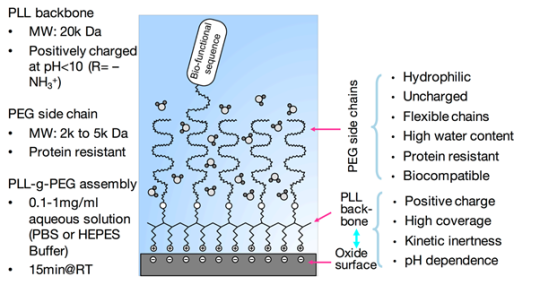
Product features
Non-biofunctionalized PEG side-chains (methoxy-terminated):
- Water soluble
- Positively charged polyelectrolyte with protonated lysine side-chains below pH=9
- Applicable from dilute aqueous buffers
- Spontaneously form a dense PEG brush on different, negatively charged substrates
- Process is self-limiting, producing reproducible and constant film thicknesses
- Coated substrates have low non-specific binding of proteins (typically less than 10 ng/cm2 from full human serum)
- Coated substrates become cell resistant
- Coated substrates are bacteria resistant
- Two versions available with 2 kDa and 5 kDa PEG side-chains and a 20 kDa PLL backbone
- Custom architectures (also possible with side-chains other than PEG, such as dextran or PMOXA) available - please ask for a quote!
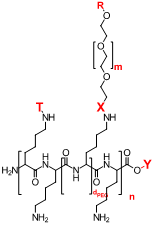
R= CH3, NTA, biotin, peptide
m=43 (MW of PEG side chain 2 kDa); 113 (MW of PEG side chain 5 kDa)
n=25 in case of g= 4 (MW of PLL backbone 20 kDa, DP=100)
dPEG=0.25 corresponding to grafting ratio g of nPEG/nLys=4
Y=CH3
T= optional fluorescent TAG, FITC, TRITC, Atto633
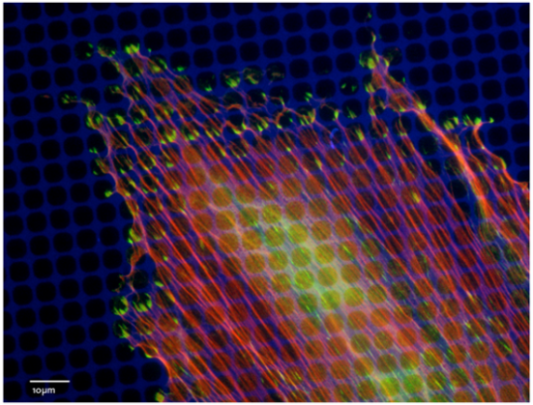
Paxillin-GFP (green) expressing Ref 52 fibroblast grown on micropatterns of 5 x 5 µm adhesive fibronectin squares separated by 1 µm PLL-g-PEG-Atto633 (blue). The cell was fixed and stained for actin using phalloidin-TRITC (red). Images were taken at a Zeiss Life Cell Station using a 63x oil immersion objective with NA of 1.4. Courtesy of F. Anderegg, Laboratory for Surface Science and Technology, ETH Zurich, www.surface.mat.ethz.ch
Fluorescently tagged, non-biofunctionalized PEG side-chains (methoxy-terminated):
- Properties as for non-bio-functionalized PEG or dextran side-chains (methoxy-terminated)
- Labels are randomly grafted directly to the polymer backbone (2-4% of the lysine groups) and therefore do not interfere with the protein-resistant properties of the coating.
- Three versions available with FITC (green label), TRITC (red label) and Atto633 (near IR label)
- Custom labeling available - please ask for a quote!
Biofunctionalized polymers:
- properties as for non-bio-functionalized PEG or dextran side-chains (methoxy terminated)
- a different proportion of PEG side-chains is functionalized, depending on the functionality
- PEG chains carrying a functional group are typically longer than the remaining PEG chains, in order to optimize surface availability
- Available functional polymers have PEG side-chains with a molecular weight of 3.4 kDa end-functionalized with biotin (20% and 50% of PEG side-chains), NTA (nitrilotriacetic acid, >90% of PEG side-chains) and RGD peptide sequence (6-15% of PEG side-chains) for specific cell binding
- Please ask for a quote!
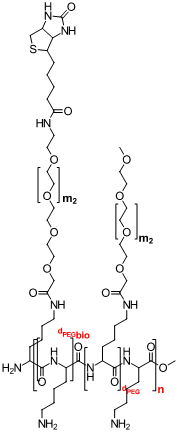
PLL(20)-g[3.5]- PEG(2)/PEG(3.4)- biotin(20% or 50%)
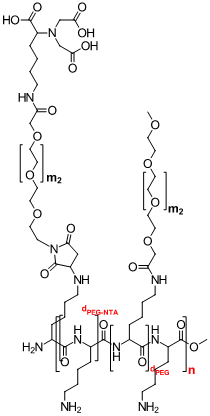
PLL(20)-g[3.5]- PEG(3.4)-NTA
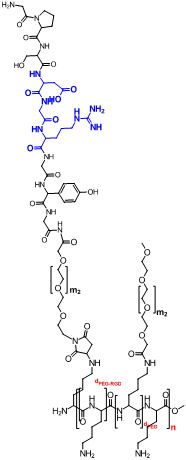
PLL(20)-g[3.5]- PEG(2)/PEG(3.4)- RGD

